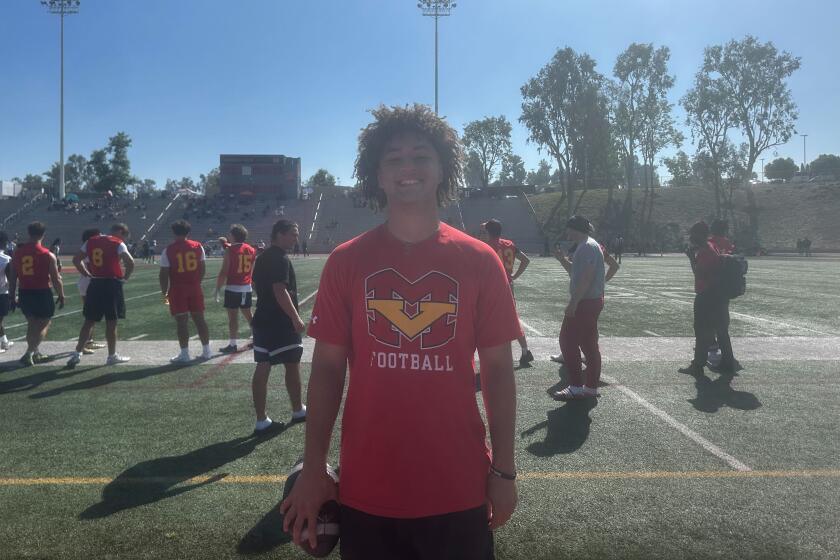Harvey Mudd’s Slick Cannon Capture Puts Caltech Under the Gun
- Share via
The perennial pranksters of Caltech were all but fodder for Harvey Mudd’s cannon caper on April Fool’s Day.
The three-ton artillery piece had rested peacefully on the Caltech campus in Pasadena until it was pilfered two weeks ago by Harvey Mudd College students--testimony to the friendly rivalry between the two highly rated technical schools.
“We pulled one over on them,” gloated Jeff Hong, a 20-year-old engineering major at the Claremont college and one of the masterminds behind the stunt. “But they’re being pretty good sports about it.”
At Caltech, the rivalry was ridiculed.
“It’s something they’re trying to start,” smirked Ed Zanelli, a 20-year-old junior and president of Fleming House, the student dormitory that had unofficially adopted the cannon. “They pride themselves on being like Caltech.”
Noting that Caltech has gained worldwide fame for its scoreboard pranks and card stunts during the Rose Bowl game, Zanelli promised a “spectacular” resolution to the artillery abduction. But for Harvey Mudd students, who for years had tried unsuccessfully to pull off such a munitions maneuver, the 18-foot Caltech cannon is evidence that the pranksters finally had been out-pranked.
“The cannon has been a symbol of the rivalry,” Hong said of the failed filchings. “This semester everything just kind of came to fruition.”
Because the gag occurred during Caltech’s spring break with no one on campus to prevent the theft, students there argued that its impact was diminished.
But Mudd students insisted that the howitzer heist was sufficiently clever. Donning hard hats and matching “H & M Construction Inc.” T-shirts, a crew of seven students spent nearly two hours jockeying the 115-year-old cannon onto a huge forklift. Another three posed as Caltech students nonchalantly playing football and tossing a Frisbee as a diversion.
When a Caltech security officer questioned them, he was referred to the “foreman,” Joe Agnese, a 27-year-old junior who is prematurely bald. Agnese waved a forged work order and said there was no time to chat.
The cannon was then placed on a flatbed truck and shipped off to its current resting spot in Claremont.
“Everyone was psyched,” Hong said. “It kind of dominates the campus.”
It was not the first time the cannon had been copped. Originally built for use in the Franco-Prussian War (1870-1871), the cannon has spent most of the 20th Century on the campus of Southwestern, formerly a military academy for boys in San Marino.
During the Vietnam War era, the academy converted to a co-ed boarding school and, in an effort to shed its military image, was more than happy to look the other way when Caltech students asked to steal the cannon in 1972.
Once it was on campus, residents of Fleming House restored the cannon for use in intramural pranks. Traditionally it was fired to signal the beginning and end of the school year, although it once was used to blow a load of Jell-O at a rival dormitory.
One such unauthorized blast shattered the windows of an administration building, prompting the cannon’s return to Southwestern. Fleming House retrieved the weapon in 1981, again with Southwestern’s permission.
Since then, Harvey Mudd students have made several unsuccessful stabs at snatching the gun, once watching in despair as the cannon’s weight blew out the tires on a rented trailer.
“We’re challenging Caltech to come get (the cannon),” Hong said. “If they’re creative, we’ll applaud.”
Not to be outdone, three U.S. Marines clad in combat fatigues were at the Claremont campus this week helping a Caltech sophomore weigh the feasibility of seizing the cannon once again.
“I don’t think they realized who they took the cannon from,” said Fleming House resident Adam Slovik, who had requested the military assistance. “It’s something we’re really close to.”
Harvey Mudd students watching the martial maneuvers weren’t impressed.
“They had to call in the Marines,” sneered junior Mark Moeglein. “We did it with 11 students.”
More to Read
Get our high school sports newsletter
Prep Rally is devoted to the SoCal high school sports experience, bringing you scores, stories and a behind-the-scenes look at what makes prep sports so popular.
You may occasionally receive promotional content from the Los Angeles Times.






